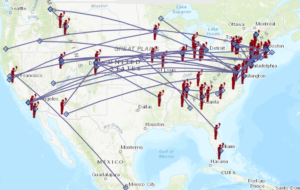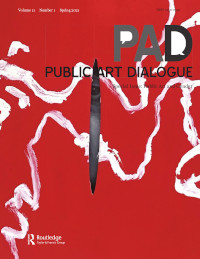Writing
Books
 Teachable Monuments: Using Public Art to Spark Dialogue and Resolve Controversies, co-edited with Jennifer Wingate and Harriet F. Senie (Bloomsbury Publishing, 2021).
Teachable Monuments: Using Public Art to Spark Dialogue and Resolve Controversies, co-edited with Jennifer Wingate and Harriet F. Senie (Bloomsbury Publishing, 2021).
The essays in this anthology provide guidelines, lessons plans, and case studies—tailored for students and teachers from kindergarten to university, community groups, civil servants, and politicians—that demonstrate how public art and monuments in North America can be used to deepen civic and historical engagement and social dialogue.
Articles
 “Commemorations of an Epoch: Women’s Suffrage Monuments in the United States,” Panorama: Journal of Association of Historians of American Art (Fall 2021)
“Commemorations of an Epoch: Women’s Suffrage Monuments in the United States,” Panorama: Journal of Association of Historians of American Art (Fall 2021)
This article was selected as the inaugural project for the Terra-funded initiative “Toward a More Inclusive Digital Art History,” which aims to increase access to data-driven methods in American art studies. The article catalogs and analyzes the uneven and sometimes misrepresentative monumental commemoration of women’s suffrage in the United States, offering new insight on the relationship of these sites to monument style, race, and historical memory. The original interactive features, including five scrollable and clickable ArcGIS maps and full data set, provide open-access resources to aid future research into public monuments to women, and so prototypes a scholarly model for leveraging and sharing research in the growing field of digital art history.
“The Politics of Commemorating the Woman Suffrage Movement in New York City”: On The Women’s Rights Pioneer Monument.” Journal of Urban History (August 2020).
“The Glendale Comfort Women Memorial and the Complications of Transnational Commemorations.” De Arte (Fall 2018.
“It’s Not About a Statue: Fred Wilson’s E Pluribus Unum.” Public Art Dialogue (2014).
Dissertation
My dissertation Monumental Women: Gender, Place, and Heroism in American Public Statues 1980-2018 analyzes more monuments to the six most-commemorated women in the United States (American Indian navigator Sacagawea; suffragists Susan B. Anthony and Elizabeth Cady Stanton; aviator Amelia Earhart; abolitionist Harriet Tubman; and civil rights activist Rosa Parks) to uncover the ways a range of constituencies across the country have reinvigorated the model of the traditional monument, once presumptively masculine, to accommodate a contemporary ideation of a heroic women. Together the monuments tell a diverse story about our contemporary engagement with issues of history, heroism, gender, race, and visual representation.
It is this monumental sea change that Monumental Women takes as its central inquiry: how these statues have come into being, who is erecting them, and for what purposes. I have toured the country from coast to coast to catalogue public statues of women, researched these women and the process of their commemoration through archives, public history, and secondary sources, and considered them against my extensive reading in discourses of commemoration.
Anthology Essays
“Your City is the Source: A Conversation About ICA/Vita Brevis.” In Museums and Public Art? Cher Krause Knight and Harriet Senie, eds. Cambridge Scholars Publishing, 2018.
“Vita Brevis: A Public Art Initiative at Boston’ Institute of Contemporary Art.” In Artists Reclaim the Commons: New Works/ New Territories / New Publics. Glenn Harper and Twlene Moyer, eds. ISC Press, 2013.
Guest Edits
Other Publications
“Sakakawea’s Long Trek to the United States Capitol: Representation and Diversity in the National Statuary Hall,” Capitol Dome (Winter 2019).
Review of What We Made: Conversations on Art and Social Collaboration, by Tom Finkelpearl. Public Art Dialogue Issue 4 no. 1 (2014).
"Uses of QR Codes in Public Art.” International Sculpture Magazine (December 2011).
